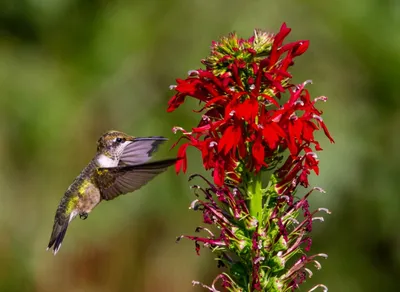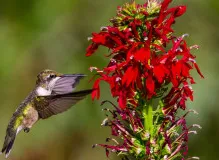For over long years, we have diligently conducted independent research and product testing. When you make a purchase through our links, we may earn a commission.
Discover the Vibrant Beauty of Ruby Red Plants - Unveiling Nature's Colorful Gems
Created: 3 weeks ago

23 min Read
Introduction
Welcome to our blog post where we will be exploring the beauty and allure of ruby red plants. From their vibrant hues to their captivating charm, these plants add a touch of elegance and sophistication to any garden or indoor space. Whether you're a seasoned gardener or simply have a green thumb, join us as we delve into the world of ruby red plants and discover their unique features and benefits. Let's dive in! 💎🌿
What are Ruby Red Plants?
Ruby red plants are a category of plants that feature deep red or crimson-colored foliage or flowers. These plants are known for their rich, eye-catching color which adds a dramatic flair to any landscape. From striking red leaves to crimson blooms, ruby red plants are a popular choice for those looking to create a bold and vibrant garden aesthetic.
Popular Varieties of Ruby Red Plants
-
Red Leaf Cordyline: With its glossy, burgundy foliage, the Red Leaf Cordyline is a show-stopper. This tropical plant adds a touch of exotic beauty to gardens and is known for its easy maintenance.
-
Red Fountain Grass: Known for its stunning deep red plumes, the Red Fountain Grass is an ornamental grass that provides a unique texture and visual interest to any landscape. It is also drought-tolerant and requires minimal care.
-
Red Japanese Maple: The Red Japanese Maple tree is a beloved choice among gardeners for its stunning scarlet leaves. This deciduous tree adds a burst of vibrant color to autumn landscapes and can be a focal point in any garden.
Benefits of Ruby Red Plants
-
Attractive Visual Impact: Ruby red plants instantly draw attention and create a striking visual impact. Their intense red color can serve as a focal point in garden beds or complement other colorful flowers or foliage.
-
Contrast and Depth: The deep red hues of ruby red plants create a sense of contrast and depth in any garden or indoor space. This adds dimension and visual interest, enhancing the overall aesthetics of the environment.
-
Stress Relief and Relaxation: Research has shown that exposure to nature and greenery can reduce stress levels and promote relaxation. Incorporating ruby red plants into your surroundings can provide a calming effect and enhance your well-being.
-
Low Maintenance: Many ruby red plants are known for their simplicity and ease of care. They require minimal maintenance, making them suitable for both experienced and novice gardeners.
Incorporating Ruby Red Plants into Your Landscape
When incorporating ruby red plants into your landscape, consider the following tips:
-
Plant Placement: Place ruby red plants strategically to create focal points or add pops of color. Consider the surrounding foliage and choose complementary or contrasting plants to enhance the overall visual appeal.
-
Container Gardening: If you have limited garden space, consider planting ruby red plants in containers. This allows for flexibility in placement and can be an eye-catching addition to patios, balconies, or indoor areas.
-
Seasonal Interest: Mix different varieties of ruby red plants to ensure year-round interest. Choose plants with varying bloom times or foliage colors to maintain a vibrant and ever-changing garden throughout the seasons.
-
Proper Care: Be sure to follow the specific care instructions for each variety of ruby red plant you choose. This may include watering requirements, sunlight exposure, and pruning guidelines.
Conclusion
Ruby red plants offer a bold and captivating addition to any garden or indoor space. With their stunning color and minimal maintenance needs, they are a popular choice among gardeners and plant enthusiasts. By incorporating ruby red plants into your landscape, you can create a visually appealing and tranquil environment that is sure to impress. So why not embrace the beauty of ruby red plants and elevate your garden to new heights? 🌹🌿
The Significance of Ruby Red in Nature's Color Palette
Nature's color palette is abundant with a wide array of hues, each carrying its own symbolism and significance. Among these vibrant colors, ruby red holds a special place, evoking a sense of passion, energy, and allure. From ruby red flowers to crimson foliage, this bold and captivating color adds a touch of drama and sophistication to the natural world.
Symbolism of Ruby Red
In many cultures and traditions, the color red symbolizes various meanings and emotions. Here are some of the key symbolic associations with the ruby red shade:
-
Passion and Love: Ruby red is often associated with passionate love, desire, and romance. It is a color that ignites powerful emotions, evoking feelings of attraction and intensity.
-
Energy and Vitality: Red is commonly linked to energy, power, and vitality. It is a color that can stimulate the senses and ignite motivation and action.
-
Courage and Strength: Ruby red is also associated with courage, strength, and determination. It represents a boldness that can overcome obstacles and face challenges head-on.
-
Leadership and Ambition: The color red is often connected to leadership qualities and ambition. It exudes a sense of confidence, assertiveness, and a drive to succeed.
Ruby Red Plants in Nature
In the realm of flora, ruby red plants hold a special allure, enchanting gardeners and nature enthusiasts with their vibrant crimson hues. These plants bring a touch of sophistication and visual impact to any landscape. Let's explore some examples of ruby red plants found in nature:
-
Red Roses: The classic symbol of love and romance, red roses are one of the most iconic ruby red flowers in the world. Their vibrant crimson petals are synonymous with passion and desire.
-
Red Maple Trees: With their stunning scarlet foliage, red maple trees create a breathtaking display during the autumn season. These majestic trees add a touch of elegance and warmth to landscapes.
-
Red Poppies: Known for their vibrant red petals, red poppies are not only visually appealing but also carry symbolic meanings such as remembrance and consolation. These delicate flowers add a pop of color to gardens and meadows.
-
Red Amaryllis: This striking flower features bold red blooms that add a touch of glamour to any floral arrangement. The red amaryllis represents radiant beauty and can brighten up indoor spaces.
Incorporating Ruby Red Plants in Design
Whether you're a landscape designer or a passionate gardener, incorporating ruby red plants into your design can create a captivating and visually appealing space. Here are a few tips for integrating ruby red plants into your garden or landscape:
-
Contrasting Combinations: Pair ruby red plants with contrasting colors to create visual interest and balance. Explore combinations such as red and white, red and green, or red and yellow to make the ruby red hues stand out.
-
Focal Points: Use ruby red plants as focal points within your garden or landscape design. Their bold color will draw attention and create a striking visual impact.
-
Seasonal Accents: Make use of ruby red plants that showcase their vibrant color during specific seasons. For example, red maple trees add a stunning display of crimson foliage in the fall, while red tulips beautify spring gardens.
-
Container Gardening: If you have limited space, consider planting ruby red plants in containers. This allows for versatility in placement, whether on balconies, patios, or even indoors.
In conclusion, ruby red plants not only add a vibrant splash of color to nature's canvas but also carry symbolic meanings associated with passion, energy, and strength. Incorporating these stunning plants into your garden or landscape design can create a visually captivating and emotionally evocative space. So, why not embrace the allure of ruby red and infuse your surroundings with its beauty and significance?
Ruby Red Plant Varieties
Ruby red plants are a stunning addition to any garden, providing a splash of vibrant color and adding visual interest. Let's explore some popular varieties of ruby red plants that will make your garden truly stand out.
- Red-Leaf Cordyline 🌿
The Red-Leaf Cordyline is a striking plant known for its bold, ruby red leaves that add a touch of drama to any landscape. This tropical plant is native to Southeast Asia and the Pacific Islands, and its vibrant foliage is sure to catch the eye. The deep red color contrasts beautifully with green plants, creating a captivating visual display. Not only does it add aesthetic appeal, but it also requires minimal maintenance, making it an excellent choice for both experienced gardeners and beginners.
- Red Fountain Grass 🌾
The Red Fountain Grass is an elegant ornamental grass with feathery plumes that emerge in a bright, ruby red color. This perennial grass adds a touch of graceful movement to any garden or landscape. The red plumes sway in the breeze, creating a mesmerizing spectacle. It is a low-maintenance plant that thrives in sunny locations and requires very little water once established. Planting Red Fountain Grass in clusters or as a border along pathways can create a stunning focal point and add texture to your garden.
- Red-Leaf Japanese Maple 🍁
The Red-Leaf Japanese Maple, also known as Acer palmatum atropurpureum, is a renowned tree that boasts brilliant red foliage. Its leaves turn a deep shade of crimson in the spring and maintain their vibrant color throughout the summer, before transitioning to fiery hues of orange and gold in the fall. The Red-Leaf Japanese Maple is a stunning addition to any garden, providing shade and adding a touch of elegance to its surroundings. It is a slow-growing tree, making it suitable for small gardens and container planting. The unique shape of its leaves and the intensity of its red color make it a true gem among ruby red plants.
- Red-Leaf Heuchera 🌺
Red-Leaf Heuchera, also known as Coral Bells, is a perennial plant prized for its attractive foliage. This versatile plant comes in various shades of red, from deep burgundy to vibrant scarlet. Its delicate, bell-shaped flowers appear in late spring or early summer, adding an extra splash of color to its red leaves. Red-Leaf Heuchera is a great choice for borders, rock gardens, or as a ground cover, and it thrives in partial shade. Its low maintenance requirements and stunning red foliage make it a favorite among gardeners.
Conclusion
Ruby red plants offer a captivating visual delight, and these popular varieties mentioned above are sure to enhance the beauty of your garden. With their striking red foliage or blooms, the Red-Leaf Cordyline, Red Fountain Grass, Red-Leaf Japanese Maple, and Red-Leaf Heuchera are excellent choices for adding a touch of drama and vibrancy to your outdoor space. Whether you plant them individually, create a focal point, or incorporate them into mixed plantings, these ruby red plants will certainly leave a lasting impression. So, go ahead and embrace the beauty of ruby red plants in your garden! 🌿🌺
Growing and caring for ruby red plants requires a keen eye for detail and a little bit of patience. These stunning plants add a touch of elegance to any landscape, but they do require some specific care to ensure their vibrant colors are maintained. In this section, we will explore the art of growing and caring for ruby red plants, covering everything from planting to pruning. Let's dive in and unlock the secrets to successful ruby red plant care! 🌿💎
1. Choosing the Right Location
When selecting a location for your ruby red plants, it's important to consider their sunlight requirements. Most ruby red plants thrive in full sun to partial shade, so choose a spot that receives at least 6 hours of direct sunlight per day. However, be wary of intense afternoon sun, as this can scorch the leaves of some varieties.
2. Soil and Watering
Ruby red plants prefer well-draining soil that is rich in organic matter. Amend the soil with compost or organic matter before planting to improve its structure and fertility. When it comes to watering, it's essential to strike a balance. While these plants like to be kept consistently moist, they should never be saturated or sit in waterlogged soil. Water deeply, allowing the water to penetrate the roots, and then allow the soil to dry slightly before watering again.
3. Fertilizing
To keep your ruby red plants looking their best, regular fertilizing is key. Use a balanced, slow-release fertilizer or a liquid fertilizer formulated for flowering or foliage plants. Apply the fertilizer according to the package instructions, taking care not to over-fertilize as this can lead to leaf burn or excessive growth.
4. Pruning and Maintenance
Pruning is an essential part of caring for ruby red plants. Regular pruning helps maintain their shape and promotes healthy growth. Start by removing any dead, damaged, or diseased branches or leaves. Additionally, prune back any overgrown or leggy stems to encourage bushier growth. Pruning can be done in late winter or early spring before new growth begins.
5. Pest and Disease Control
Ruby red plants are generally resistant to pests and diseases, but they can still fall victim to a few common issues. Keep an eye out for aphids, spider mites, or scale insects, as these pests can sometimes affect the foliage of these plants. If you notice any signs of infestation, use an organic insecticidal soap or horticultural oil to treat the affected areas.
6. Winter Care
Some ruby red plants are not winter hardy and may require protection during the colder months. If you live in an area with harsh winters, consider moving potted ruby red plants indoors or providing them with a protective cover to shield them from frost and freezing temperatures. Mulching around the base of the plant can also help insulate the roots.
By following these care tips, you can ensure that your ruby red plants thrive and continue to showcase their vibrant beauty for years to come. With proper attention and maintenance, your garden will become a stunning tapestry of ruby red hues. Happy gardening! 🌸🌱
Adding Drama and Contrast to Your landscape with Ruby Red Plants
When it comes to creating a truly captivating landscape, incorporating ruby red plants can make all the difference. These stunning plants bring a level of drama and contrast that is hard to achieve with other colors. The intense shade of red adds a bold pop of color that immediately draws attention and creates a focal point in your garden. Whether you choose ruby red foliage or vibrant red blooms, these plants are sure to make a statement.🌹💥
One way to highlight the beauty of ruby red plants is by using them as a backdrop or focal point. For example, planting a Red Japanese Maple tree near a neutral-colored wall or fence can create a stunning contrast and draw attention to both the plant and the surrounding space. The deep red leaves against a light background create a visual impact that is simply breathtaking. 🍁🔴
Another way to incorporate ruby red plants is by creating a color scheme or theme in your garden. Pairing them with plants that have complementary colors, such as purples and pinks, can create a harmonious and visually pleasing landscape. For instance, planting Red Leaf Cordyline alongside purple flowering plants like lavender or purple coneflower can create a striking combination that catches the eye. The contrast between the deep red foliage and the vivid purples adds depth and interest to your garden. 🌺🔴💜
If you prefer a more contemporary or modern garden design, consider using ruby red plants in geometric patterns or structured arrangements. The bold color of these plants can be used to create clean lines and shapes that add a touch of sophistication and elegance to your outdoor space. For example, planting Red Fountain Grass in rows or alternating with other grasses or shrubs can create a visually stunning and organized landscape. It's an excellent way to bring a sense of structure and balance to your garden. 🌾🔴
To ensure the longevity and health of your ruby red plants, make sure to provide them with the right growing conditions. Most ruby red plants thrive in well-draining soil and prefer full sun to partial shade. Regular watering and occasional fertilization can help maintain their vibrant color and overall health. Be mindful of any specific care instructions for the specific variety of ruby red plant you have chosen, as some may have individual needs. With proper care and maintenance, these plants will continue to impress with their gorgeous red hues. 🌱🔴
In conclusion, ruby red plants are an excellent addition to any landscape design, bringing drama and contrast to create a visually stunning garden. Their intense red color adds a touch of elegance and sophistication that is hard to achieve with other colors. Whether you're incorporating them as a focal point or using them to create a color scheme, ruby red plants are sure to make a statement. So go ahead, add some ruby red plants to your landscape and watch your garden come to life with vibrant beauty. 🌹💥🔴
The Symbolism of Ruby Red Plants in Different Cultures
Throughout history, plants have held symbolic meanings in various cultures around the world. The vibrant and alluring nature of ruby red plants has also been associated with symbolism and deeper interpretations. Let's explore how different cultures view and interpret the symbolism of ruby red plants.
Chinese Culture
In Chinese culture, the color red is highly significant and associated with luck, happiness, and abundance. Ruby red plants are considered auspicious and are often used in celebrations and festivals. The red color of these plants is believed to ward off evil spirits and bring good fortune to households.
Native American Culture
In Native American culture, ruby red plants are often associated with spiritual energy and power. The deep red hues symbolize strength, vitality, and the life force. These plants are used in various rituals and ceremonies to connect with the earth's energy and embrace its healing properties.
Western Culture
In Western culture, ruby red plants are often associated with love, passion, and romance. The deep red color is reminiscent of the intensity of emotions and is commonly used in floral arrangements and bouquets for expressing love and desire. Ruby red plants are often considered symbolically linked to matters of the heart.
Feng Shui
In the practice of Feng Shui, ruby red plants are believed to attract positive energy and promote balance within a space. The vibrant red color represents the fire element, which symbolizes passion, creativity, and transformation. Placing ruby red plants in specific areas of a home or workspace is thought to enhance these qualities and bring about a harmonious environment.
Conclusion
Ruby red plants hold symbolic importance and cultural significance in different parts of the world. From bringing luck and abundance to symbolizing love and passion, these plants have a timeless allure. Whether you incorporate them into your garden or indoor space for their aesthetic appeal or embrace their symbolic meanings, ruby red plants add a touch of enchantment and beauty to any setting.
Introduction
In addition to their stunning beauty, did you know that ruby red plants also offer numerous health benefits? These vibrant botanical treasures not only liven up your surroundings but can also contribute to your overall well-being. From purifying the air to reducing stress, let's explore the health benefits of incorporating ruby red plants into your living spaces. 🌿💎
1. Enhancing Air Quality and Oxygen Levels
One of the remarkable qualities of ruby red plants is their ability to act as natural air purifiers. Through the process of photosynthesis, these plants absorb carbon dioxide and release oxygen, thus improving the air quality in your space. The rich red foliage of these plants serves as a visual reminder of their impact on enhancing oxygen levels, promoting a healthier environment.
2. Boosting Mood and Reducing Stress
Being surrounded by nature has been proven to have a positive impact on our mental and emotional well-being. Ruby red plants, with their vibrant and captivating colors, add a touch of beauty and serenity to any space. Studies have shown that simply being around plants can lower stress levels, boost mood, and promote relaxation. Incorporating ruby red plants into your indoor spaces or garden can create a tranquil ambiance and contribute to your overall happiness.
3. Improving Focus and Productivity
Having ruby red plants in your work or study area can have significant effects on your focus and productivity. Research has shown that being in the presence of plants can improve cognitive function, attention span, and memory retention. By adding ruby red plants to your workspace, you can create an environment that fosters concentration and boosts productivity, helping you thrive in your daily tasks.
4. Natural Healing and Positive Energy
In various ancient traditions such as feng shui, ruby red plants are believed to bring positive energy and healing properties to a space. Their vibrant red color symbolizes passion, vitality, and abundance. By incorporating these plants into your home or office, you can invite positive energy and create a harmonious environment that supports your physical, emotional, and spiritual well-being.
5. Promoting Better Sleep
Having trouble getting a good night's sleep? Ruby red plants can help. Certain varieties, such as the Red Leaf Cordyline or Red Japanese Maple, release oxygen at night, making them ideal additions to your bedroom. These plants not only enhance the aesthetics of your sleep environment but also improve air quality and promote a more restful sleep by increasing oxygen levels.
Conclusion
Ruby red plants offer more than just visual appeal; they bring a host of health benefits to your living spaces. From purifying the air to reducing stress and promoting better sleep, these vibrant botanical wonders have a significant positive impact on your well-being. So why not incorporate ruby red plants into your surroundings and enjoy the natural boost they provide for your overall health and happiness? 💚💎
Pairing ruby red plants with other colors in your garden can create stunning combinations that will elevate your outdoor space. By strategically selecting complementary or contrasting hues, you can enhance the visual impact and create a harmonious and eye-catching display. Let's explore some captivating color combinations that will make your ruby red plants truly stand out.
1. Red and Green: A Classic Combination
One of the most classic and timeless color combinations is pairing ruby red plants with shades of green. The deep, vibrant red hues create a stunning contrast against the lush green foliage, creating a visually striking display. Consider incorporating plants like red leaf cordyline or red Japanese maple alongside greenery such as fern or hosta to achieve this elegant combination.
2. Red and Purple: A Regal Blend
For a regal and luxurious feel, combine ruby red plants with shades of purple. The rich, deep tones of both colors create a sense of drama and sophistication in your garden. Try pairing your ruby red plants with purple blooms such as lavender, salvia, or petunias. This combination is sure to make a bold statement and leave a lasting impression.
3. Red and Yellow: A Vibrant Contrast
If you prefer a vibrant and energetic color scheme, pairing ruby red plants with shades of yellow can create a stunning contrast. The warm and bold nature of both colors will add a lively and cheerful atmosphere to your garden. Incorporate yellow flowers like sunflowers, marigolds, or coreopsis alongside your ruby red plants to create a captivating blend of colors.
4. Red and Silver: A Modern Twist
For a contemporary and modern aesthetic, consider combining your ruby red plants with shades of silver or gray. The cool, metallic tones of silver create a striking contrast against the intense red hues, adding a touch of sophistication and elegance to your garden. Pair your ruby red plants with silvery foliage plants like dusty miller or lamb's ear to achieve this modern twist.
5. Red and White: Timeless Elegance
For a timeless and elegant look, you can never go wrong with pairing ruby red plants with shades of white. The crisp white tones complement the rich red hues, creating a classic and refined combination. Choose white blooms such as roses, lilies, or daisies to create a visually stunning contrast against your ruby red plants.
Remember, these are just a few examples of color combinations that work well with ruby red plants. Feel free to experiment and let your creativity flourish as you design your dream garden. By incorporating different colors, you can create a visually pleasing and captivating outdoor space that showcases the beauty of your ruby red plants.
Ruby red plants have a multitude of uses beyond their stunning visual appeal. In this section, we will explore some unique and unexpected ways to incorporate these vibrant plants into your daily life. From culinary delights to natural dyes, let's delve into the diverse uses of ruby red plants.
1. Culinary Delights
Ruby red plants can add a touch of sophistication and flavor to various culinary creations. Here are a few examples:
-
Ruby Red Basil: With its deep red leaves, ruby red basil is not only visually stunning but adds a unique flavor to dishes. Its slightly peppery taste makes it a great addition to salads, pastas, or even as a garnish for cocktails.
-
Red Stem Swiss Chard: This gorgeous red-stemmed variety of Swiss chard not only adds color to your plate but also delivers a mild earthy flavor. Sauté it as a side dish or toss it in a stir-fry for a nutritious and visually appealing meal.
-
Red Shiso: A staple in Japanese cuisine, red shiso leaves are commonly used as a garnish and in various dishes. Their distinctive flavor adds a tangy, mint-like taste to sushi, salads, and pickled vegetables.
2. Natural Dyes
The rich, deep red color of ruby red plants can be used to create beautiful and natural dyes for fabrics, yarns, and even Easter eggs. Here are a few ruby red plants that are commonly used for dyeing:
-
Madder Root: Madder root, also known as Rubia tinctorum, has been used for centuries to create a range of red hues. The roots can be harvested, dried, and then boiled to extract a vibrant red dye that can be used on various materials.
-
Hibiscus: Known for its stunning crimson flowers, hibiscus can be used to create shades of red when used as a dye. The petals can be boiled to release their natural pigments, which can then be used to color fabrics or even as a natural hair dye.
-
Red Cabbage: While not a ruby red plant per se, red cabbage can be used to create a beautiful range of purples and blues when used as a natural dye. When boiled, the cabbage releases pigments that can be used on fabrics or even to create vibrant watercolors.
Incorporating ruby red plants into your culinary creations or utilizing them for natural dyeing can add a unique touch and a pop of vibrant color to your everyday life. So why not explore the versatility of these stunning plants and let their beauty shine in unexpected ways?
Conclusion: Embracing the Timeless Elegance of Ruby Red Plants
In conclusion, 🌿💎 ruby red plants are an exquisite addition to any garden or indoor space, with their captivating beauty and striking hues. Whether you opt for the deep red foliage of the Red Leaf Cordyline, the mesmerizing plumes of the Red Fountain Grass, or the vibrant scarlet leaves of the Red Japanese Maple, these plants are sure to add a touch of timeless elegance to your landscape.
With their attractive visual impact, creating contrast and depth, and providing stress relief and relaxation, ruby red plants offer a multitude of benefits. Plus, their low maintenance nature makes them a popular choice among gardeners of all skill levels.
When incorporating ruby red plants into your landscape, remember to carefully consider placement for optimal visual impact. Whether you choose to create focal points or add pops of color through container gardening, these plants are versatile enough to enhance any space.
So why wait? Spruce up your garden with the enchanting allure of ruby red plants and transform your outdoor oasis into a haven of beauty and tranquility. Embrace the timeless elegance of these captivating plants and experience the vibrant joy they bring. Happy gardening! 🌿🌹











